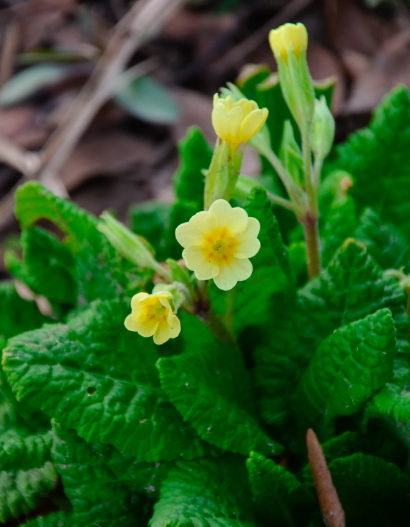Subtotal $0.00
Primroses, with their delicate beauty, are one of the first flowers to signal the arrival of spring. Known scientifically as Primula, these plants are aptly named after the Latin word “primus,” meaning first, because they bloom early, often as early as January in warmer climates.
These cheerful blooms, also called “cowslips” (though the name has no relation to cows), thrive in damp, rich soils but are surprisingly drought and heat-tolerant once established. They not only add color but can fill gaps, add texture, and provide nectar for early pollinators like bees and ladybugs. Primroses are perfect for creating a garden that feels full, rich, and naturalistic.
Growing and Caring for Primroses
While primroses love moisture, they also do well when planted in areas with morning sun. They tend to die back in the heat of summer, retreating underground to return when cooler weather arrives. I always make sure to mulch my primroses, as this helps them retain moisture and prevents temperature fluctuations that might harm them.
Primula has a vast variety of species—over 430—and though the common Primula vulgaris is widely found in nurseries, it’s not just a plant for traditional gardens. A little planning can turn these often-overlooked flowers into the stars of your spring garden.
I love grouping them en masse in similar shades for a natural, wild look. For instance, a mix of yellow, orange, and the lovely oakleaf primrose with gold-edged orange flowers creates a soft yet vibrant display.
Primrose Varieties You’ll Love
- Primula vulgaris ‘Belarina Amethyst Ice’ and ‘Belarina Cream’
The Belarina series offers primroses that are both heat and cold tolerant, blooming beautifully year after year. The ‘Amethyst Ice’ variety features blue-lavender, double-petaled flowers, while ‘Belarina Cream’ resembles a miniature gardenia with soft white blooms. Though the double-petaled form isn’t always favored by pollinators, these varieties still offer a stunning visual impact. - Primula vulgaris ‘Oakleaf Yellow Picotee’
This primrose stands out with its tall, 18-inch stems and delicate yellow petals outlined in orange. The oakleaf-shaped foliage sets it apart from other primulas. This variety is also more resistant to slugs and snails, making it a tough choice for any garden. - Primula vulgaris ‘Drumcliff’ (Irish Primrose)
Though I lost my beloved Irish Primroses during a move, they remain a garden favorite. These hybrids from Joe Kennedy’s breeding program have maroon-colored foliage, and their flowers offer rich color and texture. A great substitute is Primula vulgaris ‘Guinevere’, which features similar maroon-tinged foliage. - Primula japonica (Candelabra Primrose)
Candelabra primroses thrive in rich, moist soils and are perfect for creating a vertical display in your garden. With tiered flowers on tall stems, they bring a touch of elegance and sophistication. The foliage is lush and crinkled, adding to their visual appeal. - Primula polyanthus (Gold Laced Group)
While these primroses are beautiful, they can be a challenge in hot, dry climates. However, they make an excellent choice for cooler regions or can be used temporarily in window boxes or containers. Their striking flowers are worth the effort if you’re in the right climate.
Tips for Growing and Using Primroses
Primroses are excellent for creating a naturalistic garden, where plants interact with one another, creating a sense of wild beauty. These flowers thrive when planted in clusters or drifts, making them perfect for filling gaps left by perennials or adding color in the early spring. They’re great companions for snowdrops, narcissus, and muscari, providing a beautiful contrast.
To encourage them to reseed and spread, avoid removing dead flowers too quickly. Let the plants naturally drop seeds, and you’ll enjoy the benefits of more plants in the future. Dividing primroses in early spring is also a great way to propagate them—simply dig up the plant, separate the roots, and replant to create new additions to your garden.
Primroses also work wonders in small spaces or shady corners, where they can add an elegant touch. Their small size and delicate nature make them ideal for container gardening, as well as for creating ground-level drifts.
Whether you’re planting them for their charm, their ability to brighten gloomy days, or their value to pollinators, primroses offer a versatile and beautiful solution for many gardens. Let them be a part of your garden’s transformation, bringing life and color to the early spring months.












